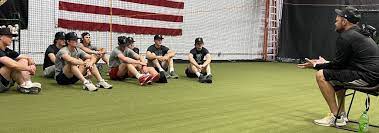What is muscling up?
In our last article we talked about velocity fluctuation, yet we didn’t discuss the issue of muscling up.
For starters, what is muscling up? Muscling up is the acting on your body tightening up during the throwing process due to the thought process of attempting to throw the ball harder. Your mechanics are the smoothest when your muscles aren’t tight, allowing them to flow properly and sequence as they should.
Why is tightening your muscles when you throw so bad?
A classic example is thinking of your body as a whip. Your legs are the handle of the whip, and your arm is the tip, with the rest of your body being the middle of the whip. A whip works best when there are no knots in it, nothing to stop its flow of energy; the same is to be said about the body. The smoother energy is transferred, the more energy will be output.
An athlete may be able to squat more than another athlete or jump farther, but if they cannot sequence their body properly and constantly muscle up, then they have created a great amount of unusable energy. Once they can sequence properly and stop muscling up, this energy has the ability to be used and create an increase in ball velocity.
Types of muscling up
There are multiple type of muscling up, each one dependent on the part of the body
Lower body
Pushing/jumping off the mound is the primary way that the lower half shows muscling up. The lower half needs to relax into rotation in order to transfer energy from the legs to the hip and up the back into the arm. Doing this creates a higher rate of energy exchange in comparison to pushing off and relying on the hips to create more energy, making up for the lower half cutting of the energy flow.
Middle body
The lower back and core need to be loose in order to properly transfer energy. The main cause of this is a forced rotation of the hips/lower back in order to feel that you are rotating faster, but in reality, your timing and speed of rotation creates additional tension in this area, creating a loss of energy at this transfer point.
You tell when a pitcher is muscling up with their lower back by a lack of hip/shoulder separation and the timing of when those body parts sequence.
Upper body
Muscling up with the arm is the most common type of muscling up among pitchers. This is seen when a pitcher is creating excess tension in their arm during the arm spiral into release. This is most common when an athlete is thinking of throwing at max effort, thinking that using more muscles creates a higher ball velocity, when in reality it tightens up their body and doesn’t allow for energy to flow through properly.
Key tip: Don’t think “throw hard”, this thought process leads to muscling up. Think throwing “quick and loose”, this tricks the mind into keeping the body calm and releasing tension that could occur.
Closing: Being 100% loose is not the answer either. Each person is different, but I do know that being tight is not the answer. Experiment what is best for you and try to create the best energy transfer that you possibly can.
Keep working hard.
Cover photo credit: Ben Brewster



